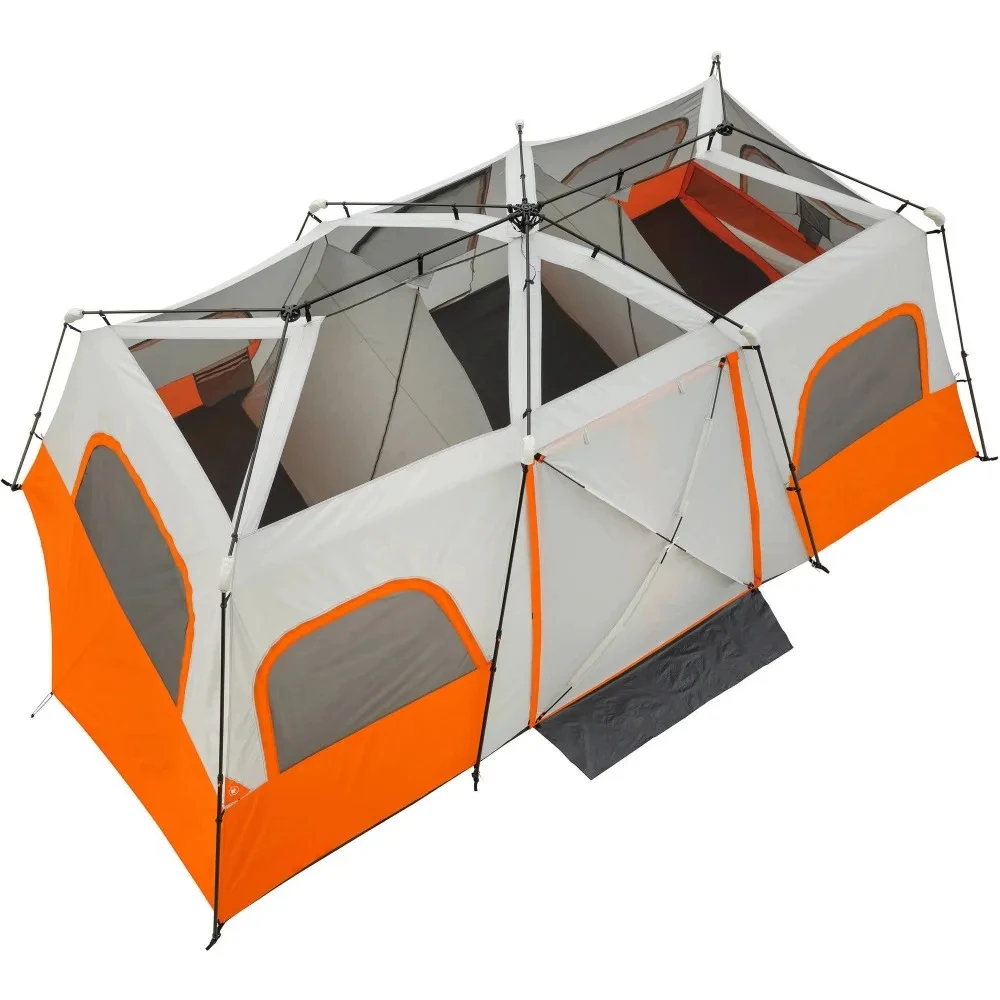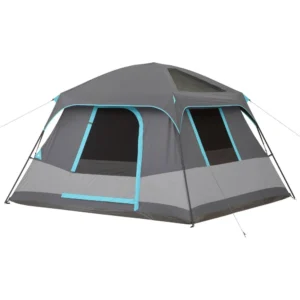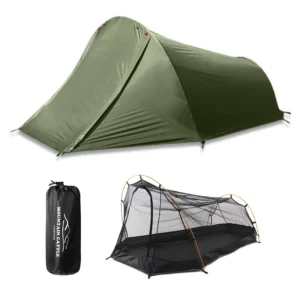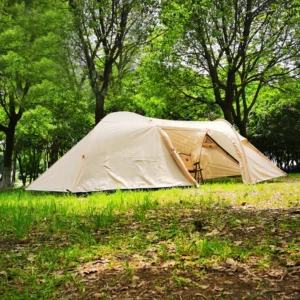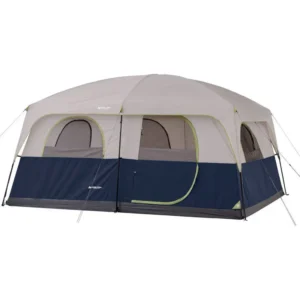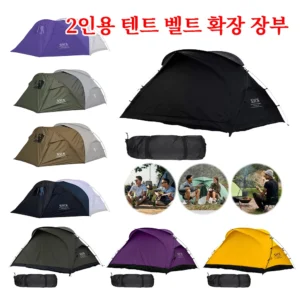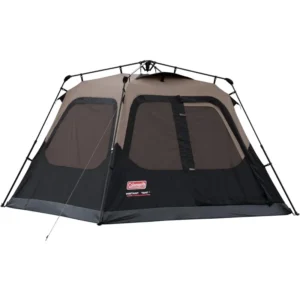Introduction: The Gateway to Comfortable Family Camping
When it comes to family camping, the design of your tent entrance can make or break your outdoor experience. An “upright entry design” refers to tent doorways and structures that allow adults to enter and exit while standing at full height, eliminating the need to crawl, stoop, or crouch. This seemingly simple feature represents a significant evolution in camping comfort, transforming the camping experience from one of compromise to genuine enjoyment.
Upright entry tents have revolutionized family camping by addressing one of the most common complaints about traditional tents: the awkward, often uncomfortable process of getting in and out. Instead of hunching over or crawling on hands and knees—particularly challenging when carrying gear or helping children—these designs prioritize natural movement and accessibility.
Throughout this guide, we’ll explore the various benefits of upright entry designs, examine different tent styles that incorporate this feature, highlight essential factors to consider when shopping, and provide recommendations for families seeking to upgrade their camping comfort. Whether you’re planning weekend getaways or extended outdoor adventures, understanding how shelter options for two campers differ from family-sized accommodations with upright entries will help you make informed decisions for your next outdoor investment.
Key Benefits of Upright Entry Family Tents
The advantages of family tents with upright entry designs extend far beyond simple convenience, addressing practical challenges that can affect the entire camping experience. These thoughtfully designed tents deliver multiple benefits that enhance comfort for all family members.
Enhanced Accessibility
Upright entry designs make camping more inclusive and comfortable for everyone:
* Easier access for grandparents or family members with limited mobility
* Reduced strain on knees and backs when entering and exiting
* Simplified entry for parents carrying young children
* Greater independence for children who can manage proper doors more easily
* Accommodating for taller family members who would otherwise need to contort themselves
The accessibility improvements of tents designed for elderly campers extend to all family members, making camping more enjoyable across generations.
Superior Headroom and Living Space
Beyond just the entryway, these tents typically offer:
* Standing height throughout most of the tent interior
* Room to stretch, change clothes, and move naturally
* Reduced feelings of claustrophobia during extended stays
* Space to set up portable tables, chairs, and camping furniture
* Ability to use the tent as a true living space during inclement weather
* More comfortable environment for playing games or spending family time together
Simplified Nighttime Use
The practical benefits of upright entries become especially apparent during nighttime:
* Easier navigation during middle-of-the-night bathroom trips
* Reduced noise and disruption to sleeping family members
* Better visibility when using flashlights or lanterns
* Quicker exits during emergencies or sudden weather changes
* Less likelihood of tripping or stumbling in the dark
Weather Protection and Gear Management
Many tall stand-up camping tents include advanced features for weather protection:
* Vestibules with standing height for removing wet gear before entering
* Protected space for boots and shoes at the entrance
* Better water runoff design around door areas
* Improved airflow patterns that reduce condensation
* Ability to shake out wet items without stooping
Psychological Comfort
The impact on overall camping enjoyment shouldn’t be underestimated:
* Reduced feeling of “roughing it” for family members new to camping
* Less physical strain leads to more positive camping experiences
* More natural movement creates a home-like comfort level
* Greater willingness to use the tent during daytime hours
* Enhanced feeling of spaciousness reduces camping anxiety
Understanding Different Upright Entry Tent Designs
When shopping for family tents with upright entries, you’ll encounter several distinct design approaches, each offering different advantages for comfort and practicality. Understanding these variations will help you select the optimal design for your family’s needs.
Cabin-Style Tents
Cabin tents represent the gold standard for upright entry designs with their nearly vertical walls and box-like structure:
* Maximum interior volume and usable space
* Typically the tallest peak heights (often 6-7 feet/183-213 cm)
* Multiple doors that often feature full-height design
* Room dividers that maintain standing height throughout
* Excellent for longer camping stays and larger families
* Often heavier and more time-consuming to set up
The rectangular footprint and straight walls of cabin tents maximize interior space but require more poles and materials, making them heavier than other designs.
Tunnel Tents with Elevated Entryways
Tunnel tents offer an excellent balance between space efficiency and comfort:
* Semi-circular or arched design with good headroom along the center line
* More aerodynamic than cabin styles, often performing better in wind
* Better space-to-weight ratio than cabin tents
* Usually feature one or two upright entry doors at the ends
* Good option for families who camp in various weather conditions
Mastering tent setup is generally easier with tunnel designs compared to more complex cabin structures, though they may offer less standing room throughout.
Hybrid Dome-Cabin Designs
These increasingly popular designs combine elements of traditional dome tents with cabin-style features:
* Dome structure at the top for wind stability and rain shedding
* More vertical walls than traditional domes, particularly around entryways
* Better headroom than pure dome tents
* Often feature D-shaped doors that maximize opening height
* Good compromise between stability and interior space
Multi-Room Configurations
For larger families, two-room camping tents offer privacy along with upright entry features:
* Separate sleeping compartments connected by a central living area
* Multiple entry points, typically with at least one tall door
* Internal doorways that maintain standing height between compartments
* Versatile space arrangements for different family needs
* Greater privacy than single-room designs
| Tent Design | Typical Peak Height | Entry Height | Wind Performance | Setup Complexity |
|---|---|---|---|---|
| Cabin | 6-7 ft (183-213 cm) | 5-6.5 ft (152-198 cm) | Moderate | High |
| Tunnel | 5.5-6.5 ft (167-198 cm) | 5-6 ft (152-183 cm) | Good | Medium |
| Hybrid | 5-6.5 ft (152-198 cm) | 4.5-6 ft (137-183 cm) | Very Good | Medium |
| Multi-Room | 6-7 ft (183-213 cm) | 5-6.5 ft (152-198 cm) | Moderate | Very High |
Door Types and Configurations
The specific door design significantly impacts the upright entry experience:
* D-doors: Offer wide, tall openings with a curved top and straight side
* T-doors: Provide maximum height at the center with slightly lower sides
* Vertical doors: Most similar to a house door, offering consistent height
* Vestibule configurations: Range from simple awnings to fully enclosed spaces
Essential Features to Look for in Upright Entry Family Tents
When evaluating family tents with upright entries, several critical features determine whether the tent will truly deliver on the promise of comfortable access and interior space.
1. Door Height Measurements
The most fundamental measurement for tents with full-height doors is the actual entry height:
* Look for door openings of at least 5‘10” (178 cm) for true standing entry
* Measure the width as well as height—narrower doors can still require awkward movements
* Check how the door opening relates to the tent’s peak height
* Consider the step-over height at the bottom of the door—lower thresholds are easier for children and older adults
2. Wall Angle and Interior Volume
The angle of the tent walls dramatically affects usable space:
* More vertical walls = more usable interior volume
* Look for wall angles of at least 80-85 degrees for maximum usability
* Avoid designs where only the very center reaches standing height
* Consider the total area where an adult can stand upright, not just peak height
3. Peak Height vs. Usable Standing Area
Many tent specifications can be misleading if you focus solely on maximum height:
* A tent with a 6‘6” (198 cm) peak height might only provide standing room in a small central area
* Evaluate the diameter or area of full standing height (should be at least 3-4 feet/91-122 cm wide)
* Check whether multiple family members can stand comfortably at once
* Consider how much stooping is required when moving away from the center point
4. Vestibule Design
The vestibule area serves as a critical transition zone between outdoors and tent interior:
* Look for vestibules with their own standing height
* Check vestibule floor area—ideally 10-15 square feet (0.9-1.4 square meters) minimum
* Evaluate vestibule door designs for ease of access
* Consider whether the vestibule has a waterproof floor or is ground-level only
5. Weather Resistance Considerations
Taller tent designs face unique weather challenges:
* More substantial pole structures required for stability
* Reinforced guy-out points to withstand higher wind loads
* Quality rainfly coverage, particularly around tall doorways
* Proper ventilation to prevent condensation in the larger interior volume
6. Setup Complexity
Larger upright entry tents often require more complex setup:
* Look for color-coded poles and connection points
* Consider quick-pitch or instant setup options for easier assembly
* Check the number of poles required—generally more poles mean more setup time
* Evaluate whether the tent can be set up by one person or requires multiple people
7. Material and Construction Quality
The structural demands of upright designs require superior materials:
* Heavier-duty poles (usually aluminum rather than fiberglass)
* Higher denier floor and wall fabrics to support the larger structure
* Reinforced seams at critical connection points
* Quality zippers that can withstand the stress of larger doors
Top Family Tents with Exceptional Upright Entry Design
After extensive testing and evaluation, we’ve identified the standout family tents that excel in providing comfortable upright entry designs while meeting diverse camping needs.
Best Overall Upright Entry Family Tent
North Face Wawona 6
* Door height: 6‘2” (188 cm)
* Peak height: 6‘8” (203 cm)
* Standing area: Approximately 80% of floor space
* Capacity: 6 person
* Entry design: Single oversized D-door with vestibule
* Setup time: Approximately 10-12 minutes
* Weight: 20 lbs 15 oz (9.5 kg)
What makes it exceptional: The Wawona combines a spacious interior with near-vertical walls and an exceptionally well-designed vestibule that provides protected entry even during rain. The single-wall construction at the door area eliminates the need to zip through multiple layers, while the generous interior dimensions allow adults to move freely throughout most of the tent.
Best Premium Option for Maximum Height and Space
REI Co-op Wonderland 6
* Door height: 6‘4” (193 cm)
* Peak height: 6‘9” (206 cm)
* Standing area: Approximately 90% of floor space
* Capacity: 6 person
* Entry design: Two oversized vertical doors
* Setup time: Approximately 15 minutes
* Weight: 22 lbs 15 oz (10.4 kg)
What makes it exceptional: The Wonderland features nearly vertical walls throughout, creating house-like interior volume. Both doors offer full standing height with minimal threshold, making this tent exceptionally accessible. The premium materials and construction quality contribute to excellent stability despite the tall profile.
Best Value Upright Entry Tent
Coleman Skylodge 12-Person Tent
* Door height: 5‘8” (173 cm)
* Peak height: 6‘7” (201 cm)
* Standing area: Approximately 70% of floor space
* Capacity: 12 person (or 6-8 with generous space)
* Entry design: Front and back D-doors
* Setup time: Approximately 15 minutes
* Weight: 34 lbs (15.4 kg)
What makes it exceptional: The Skylodge delivers remarkable value with its cabin-style design and near-vertical walls, providing excellent headroom throughout most of the tent at a fraction of the cost of premium options. The oversized doors make entry and exit comfortable for most adults.
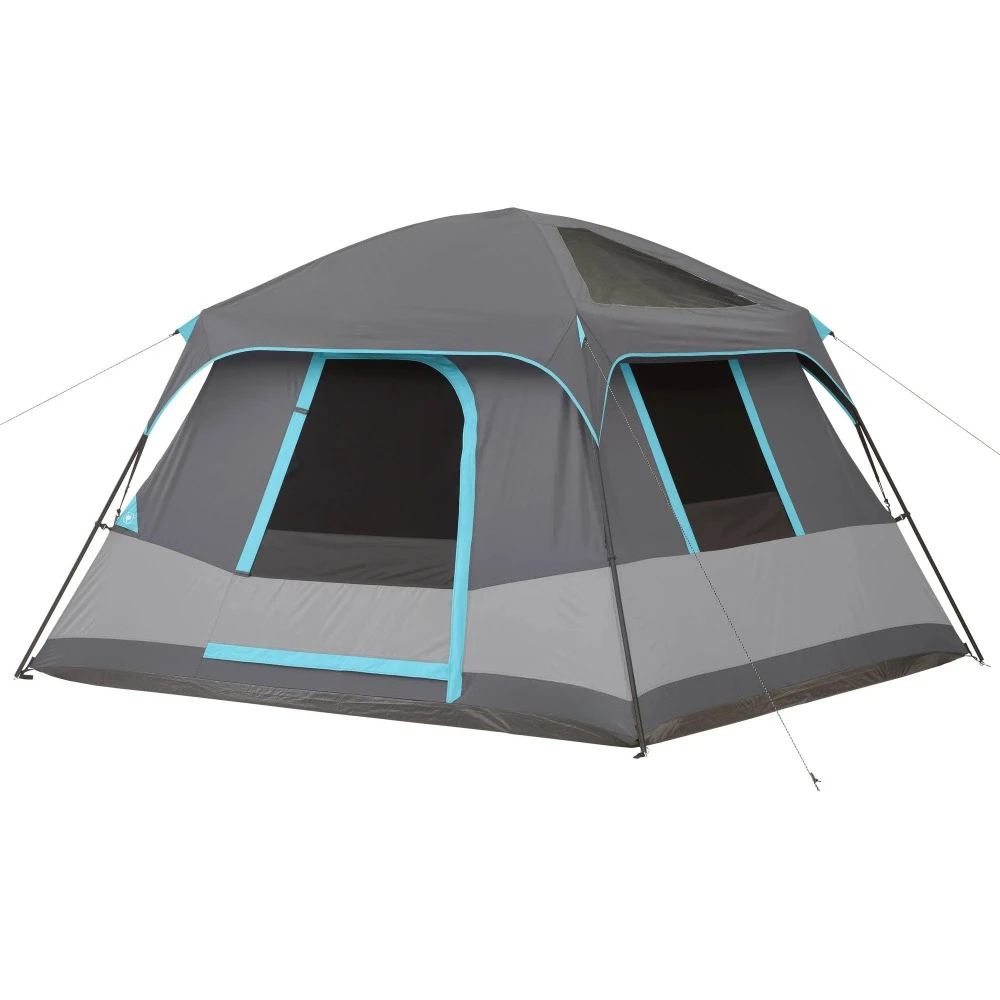
Most Weather-Resistant Tall Tent
Marmot Limestone 8P
* Door height: 5‘8” (173 cm)
* Peak height: 6‘4” (193 cm)
* Standing area: Approximately 60% of floor space
* Capacity: 8 person
* Entry design: Two D-doors with protective awnings
* Setup time: Approximately 12 minutes
* Weight: 26 lbs 7 oz (12 kg)
What makes it exceptional: The Limestone balances impressive headroom with excellent stability in adverse weather. Its pole structure creates more vertical walls than typical dome designs while maintaining superior wind resistance. The doors are positioned to maximize accessibility while being well-protected by the rainfly.
Best Multi-Room Family Tent with Upright Passageways
Ozark Trail 12-Person 3-Room Instant Cabin Tent
* Door height: 5‘10” (178 cm)
* Peak height: 6‘10” (208 cm)
* Standing area: Approximately 85% of floor space
* Capacity: 12 person
* Entry design: Two T-doors with minimal threshold
* Setup time: Approximately 2 minutes (instant frame design)
* Weight: 55 lbs (25 kg)
What makes it exceptional: This instant camping tent excels with its rapid setup despite its large size. The three-room configuration provides privacy while maintaining standing height throughout, including in the doorways between rooms. The instant frame design eliminates complex pole assembly while still achieving impressive interior height.
Comparative Analysis: Finding Your Perfect Upright Entry Tent
When selecting the ideal upright entry tent for your family, several factors must be weighed against each other to find the right balance for your specific needs.
| Tent Model | Standing Area % | Door Height | Weather Resistance | Setup Time | Weight | Price Range |
|---|---|---|---|---|---|---|
| North Face Wawona 6 | 80% | 6‘2” (188 cm) | Excellent | 10-12 min | 20.9 lbs (9.5 kg) | High |
| REI Wonderland 6 | 90% | 6‘4” (193 cm) | Very Good | 15 min | 22.9 lbs (10.4 kg) | Premium |
| Coleman Skylodge 12 | 70% | 5‘8” (173 cm) | Good | 15 min | 34 lbs (15.4 kg) | Budget |
| Marmot Limestone 8P | 60% | 5‘8” (173 cm) | Excellent | 12 min | 26.5 lbs (12 kg) | High |
| Ozark Trail 12P | 85% | 5‘10” (178 cm) | Moderate | 2 min | 55 lbs (25 kg) | Budget |
Balancing Priorities
When comparing tent layouts and sizes, consider which factors matter most for your camping style:
For car camping with minimal walking distance:
Weight becomes less critical, allowing you to prioritize interior space and comfort features. The REI Wonderland or Ozark Trail options provide maximum living space with their near-vertical walls.
For camping in varied weather conditions:
The Marmot Limestone offers the best balance of upright entry convenience with weather resistance, making it suitable for extended trips or unpredictable conditions.
For families needing quick setup:
The Ozark Trail’s instant design dramatically reduces setup time, a significant advantage when arriving at a campsite with tired children or in fading daylight.
For balanced performance:
The North Face Wawona delivers the best overall balance of standing height, weather performance, and reasonable weight, making it versatile for most family camping scenarios.
Maximizing Comfort in Your Upright Entry Tent
Once you’ve selected a tent with an upright entry design, several techniques can further enhance your camping comfort and convenience.
Strategic Tent Positioning
Proper tent orientation significantly impacts the functionality of your entryway:
* Position the main door facing away from prevailing winds when possible
* Orient the door toward your main camp area for convenient access
* Ensure the entry area is on flat, debris-free ground
* Consider morning sun angles to prevent overheating (especially for east-facing doors)
* Allow sufficient clearance around the door for easy access with gear
Vestibule Organization
The camping tent vestibule serves as a critical transition space:
* Install a small outdoor mat just outside the door to reduce dirt tracking
* Create designated areas for clean vs. dirty items
* Use hanging organizers specifically designed for vestibule spaces
* Position footwear with soles facing away from the inner tent door
* Consider a small folding chair in larger vestibules for gear changing
Interior Layout Optimization
Arrange your tent interior to maximize the benefits of the upright entry:
* Create a clear pathway from the door to the rear of the tent
* Position sleeping areas away from high-traffic entry zones
* Use the tallest sections for changing clothes and gathering spaces
* Install hanging organizers to utilize vertical space
* Consider a small indoor mat just inside the door as a “landing zone”
Lighting Considerations
Proper lighting enhances the functionality of upright entries:
* Install lantern hooks near the door area for nighttime visibility
* Consider string lights along the top ridge for ambient illumination
* Keep headlamps or flashlights in accessible pouches near the door
* Use reflective guylines and stakes around the entry area
* Consider motion-sensor lights for improved nighttime safety
Tall / Stand Up Camping Tent, Two Room Camping Tent
$407.93 Select options This product has multiple variants. The options may be chosen on the product pageCompact Backpacking Tent, Lightweight Backpacking Tent, Waterproof Camping Tent
$335.52 Select options This product has multiple variants. The options may be chosen on the product pageCamping Tent with Vestibule, Waterproof Camping Tent
Price range: $407.89 through $479.48 Select options This product has multiple variants. The options may be chosen on the product page- $476.52 Select options This product has multiple variants. The options may be chosen on the product page
Backpacking Tent with Vestibule, Trekking Pole Backpacking Tent, Waterproof Camping Tent
Price range: $271.99 through $519.52 Select options This product has multiple variants. The options may be chosen on the product pageEasy Setup Camping Tent, Instant Camping Tent
Instant Cabin Tent Double Layer Canvas 1-Minute Setup Spacious Family Camping Shelter with Air Vents$308.10 Select options This product has multiple variants. The options may be chosen on the product page
Weather Considerations for Tall Entry Tents
Family tents with upright entries face unique challenges in adverse weather conditions due to their height and often more vertical wall designs. Understanding these challenges and implementing proper techniques will ensure your comfort and safety.
Wind Stability Challenges
The taller profile of upright entry tents creates greater wind resistance:
* Always use all provided guy lines, especially those supporting the door frame
* Position the tent with the lowest profile facing prevailing winds when possible
* Consider adding additional heavy-duty stakes for increased stability
* Be aware that cabin-style designs with flat walls face greater wind loads
* During severe weather, avoid standing height areas that may collect wind force
Proper Staking and Guying Techniques
For maximum stability in waterproof camping tents:
* Use sturdy stakes appropriate for your ground conditions
* Stake guy lines at 45-degree angles from the tent
* Ensure guy lines supporting tall walls and entries have proper tension
* Consider additional aftermarket guy lines for critical structural points
* Use adjustable tensioners to maintain proper tension as conditions change
Rain Management Around High Entryways
Tall doorways require special attention to prevent water infiltration:
* Ensure rainfly coverage extends fully over door zippers
* Position the tent so water runoff flows away from the entryway
* Consider additional tarps or awnings over main doors during heavy rain
* Check that door awnings are properly angled for water runoff
* Keep door zippers fully closed when not in use to prevent water seepage
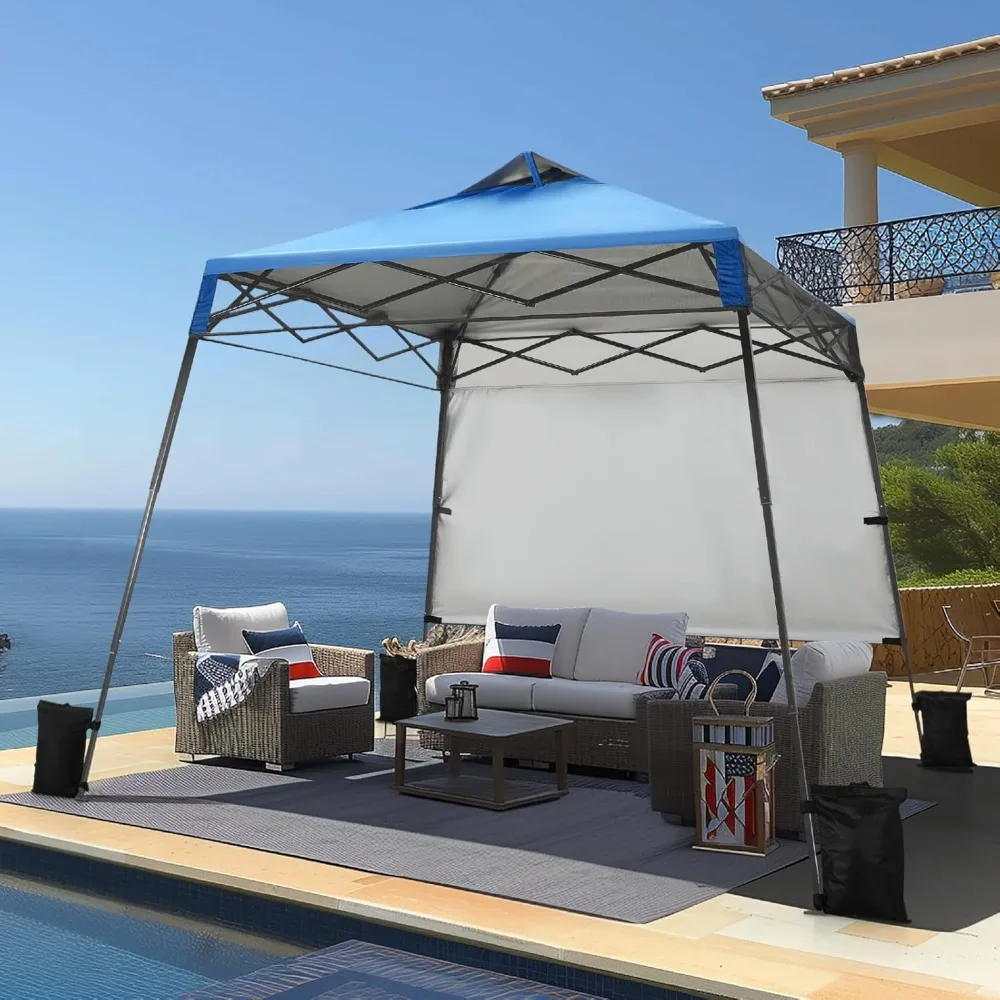
Seasonal Adaptations
Modify your approach based on seasonal conditions:
* Summer: Maximize ventilation by keeping doors open with bug screens closed
* Fall/Spring: Position the tent to capture morning sunlight on the entry area
* Winter: Consider adding an entry mat to prevent snow tracking
* High wind seasons: Choose more aerodynamic hybrid designs over full cabin styles
Frequently Asked Questions About Upright Entry Family Tents
Are upright entry tents more difficult to set up?
Generally, yes. Tents designed with standing height typically require more poles and structural supports than lower-profile designs. Setup times for family-sized upright entry tents typically range from 10-20 minutes, depending on design complexity. However, some instant or quick-pitch models have simplified this process considerably, with setup times as low as 2 minutes. Having two people for setup is recommended for most models.
How do vertical wall tents perform in strong winds?
Vertical walls catch more wind than sloped designs, making some upright entry tents less ideal for extremely windy conditions. However, manufacturers have addressed this by incorporating stronger pole materials and extensive guying systems. When properly secured, quality upright entry tents can withstand moderate winds (20-30 mph/32-48 kph). For severe weather, hybrid designs that blend dome elements with vertical features typically offer better wind performance.
Is there a significant weight penalty for choosing an upright entry design?
Yes, upright entry tents typically weigh 20-50% more than their lower-profile counterparts with similar floor dimensions. For example, a standard 6-person dome tent might weigh 15-18 pounds (6.8-8.2 kg), while a 6-person cabin-style tent with upright entry often weighs 22-30 pounds (10-13.6 kg). This weight difference results from additional poles, sturdier materials, and more fabric required to create vertical walls.
What’s the difference between “peak height” and “usable standing height”?
Peak height simply measures the highest single point inside the tent, while usable standing height refers to the area where an average adult can stand without stooping. A tent might advertise a 6‘6” (198 cm) peak height, but if this height is only achieved at one central point, the usable standing area might be quite limited. Better upright entry tents maintain at least 5‘10” (178 cm) of height across a substantial portion of the interior.
How do I properly care for and store my upright entry tent?
Larger tents with upright entries require special attention when storing:
* Always dry completely before storage to prevent mold and mildew
* Clean dirt from zippers and pole connections after each use
* Store poles assembled but relaxed to reduce tension on shock cords
* Consider larger storage bags than those provided to reduce folding stress
* Store in a cool, dry place away from direct sunlight
Are cabin-style tents suitable for all weather conditions?
While cabin-style tents excel in providing maximum interior space and comfort, they’re not ideal for all conditions. Their tall, vertical walls make them more vulnerable to strong winds compared to lower-profile dome designs. Most quality cabin tents can handle light to moderate rain and wind, but for camping in exposed areas or during unpredictable weather, choosing the ultimate compact shelter with a hybrid design may be more appropriate.
Expert Tips: Setting Up Your Upright Entry Tent
Proper setup is crucial for maximizing the benefits of your upright entry tent while ensuring stability and weather protection.
Site Selection
- Choose level ground with good drainage, ideally with a slight slope away from the door
- Remove sticks, stones, and debris that could damage the tent floor
- Position on slightly higher ground than surrounding areas if possible
- Allow at least 3 feet (1 meter) of clearance around all sides
- Consider sun exposure—morning sun on the door can help dry overnight condensation
Setup Sequence
- Lay out the tent body with the door facing your desired direction
- Assemble poles according to manufacturer instructions, connecting segments fully
- Insert poles through sleeves or attach to clips, starting with main support poles
- Elevate the structure gradually, securing corners as you go
- Stake down corner points before adding tension to the structure
- Attach the rainfly, ensuring proper alignment over doors and windows
- Secure all guy lines, particularly those supporting the entryway and tall walls
Common Setup Mistakes to Avoid
- Rushing the pole insertion process, which can damage pole segments
- Improper rainfly alignment that leaves door zippers exposed to rain
- Insufficient tension on guy lines supporting tall walls
- Overlooking small tears or damage that can worsen in tall structures
- Setting up on uneven ground, which can stress door zippers when entering/exiting
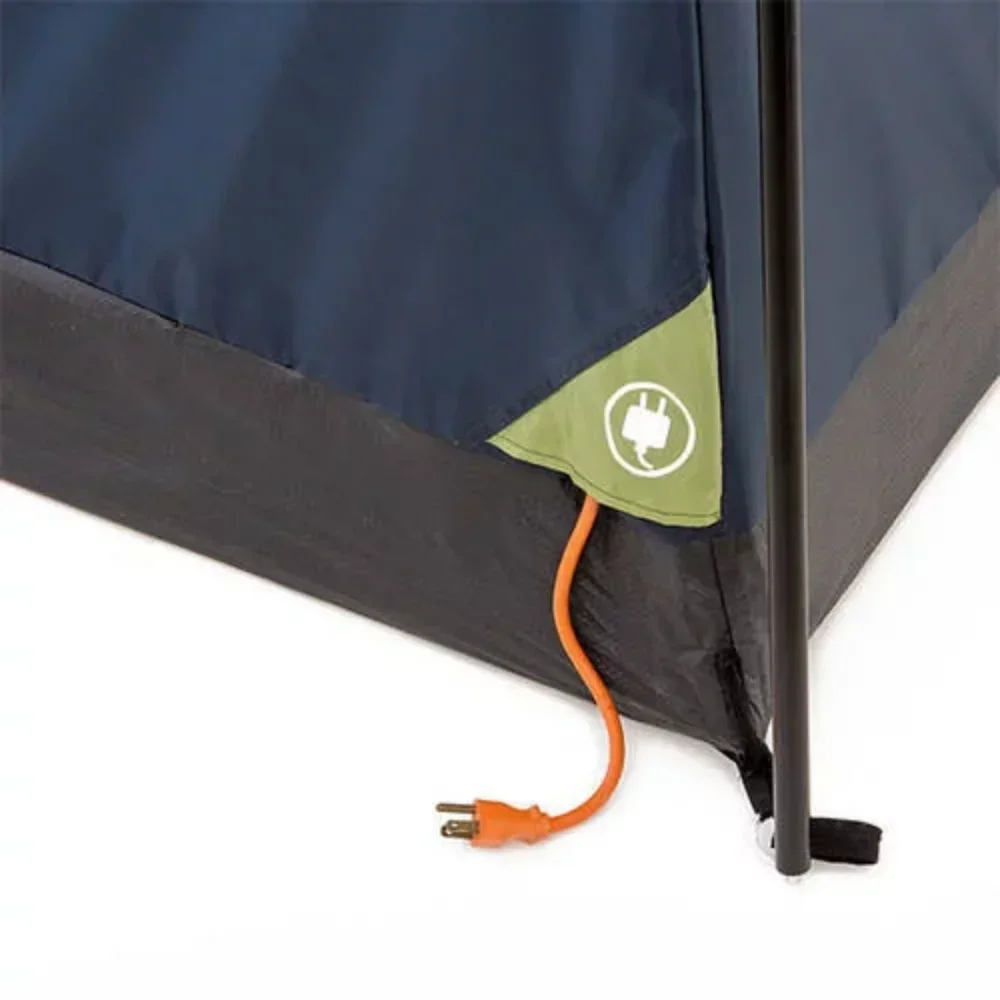
How We Evaluate Upright Entry Family Tents
At Explore Elements, our assessment process for family tents with upright entries follows rigorous protocols designed to identify the most comfortable and practical options.
Our testing methodology includes:
- Physical measurements of door openings, peak heights, and standing areas
- Practical entry/exit testing with various-sized adults carrying gear
- Multiple setup and takedown trials to determine true setup complexity
- Weather testing in controlled conditions including simulated rain and wind
- Load testing on zippers and structural components
- Durability assessment through repeated use in varied conditions
We focus particularly on the user experience around entry points, measuring not just maximum dimensions but practical usability factors like zipper smoothness, threshold height, and ease of operation. Our assessment team includes camping experts with diverse body types and heights to ensure recommendations work well for a range of users.
Final Thoughts: Why Upright Entry Makes a Difference
The upright entry design represents more than just a convenient feature—it fundamentally transforms the family camping experience. By eliminating one of the most common sources of camping discomfort—the awkward stooping, crawling, and contorting required by traditional tent designs—these tents create a more accessible and enjoyable outdoor experience for all family members.
The value proposition extends beyond simple convenience. When family members can enter and exit comfortably, move naturally within the tent, and avoid the physical strain of constant hunching, the entire camping experience becomes more positive. Children, seniors, and those with any mobility limitations benefit particularly from these designs, making camping more inclusive for the entire family.
While upright entry tents typically command premium prices and carry additional weight, the comfort benefits they provide make them worth the investment for most family campers. By prioritizing this feature in your purchasing decision, you’re investing in more than just a tent—you’re investing in better camping experiences and creating more positive outdoor memories for your entire family.

